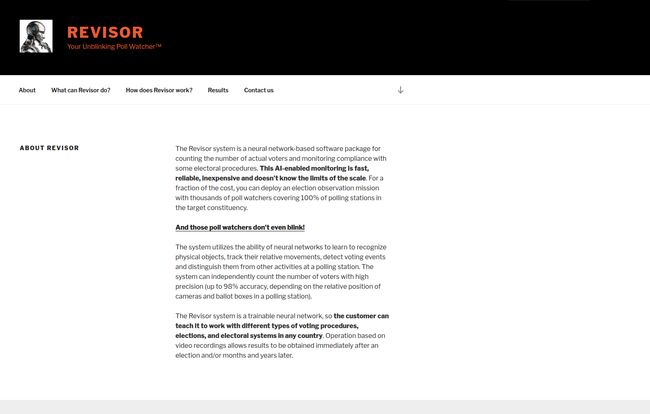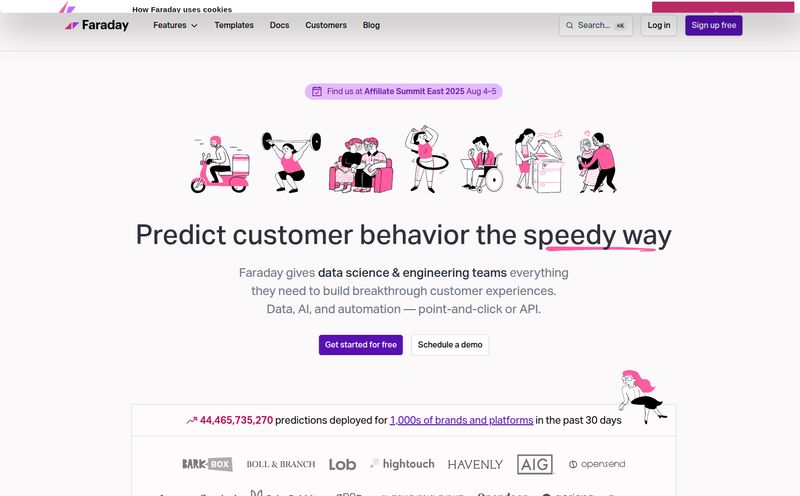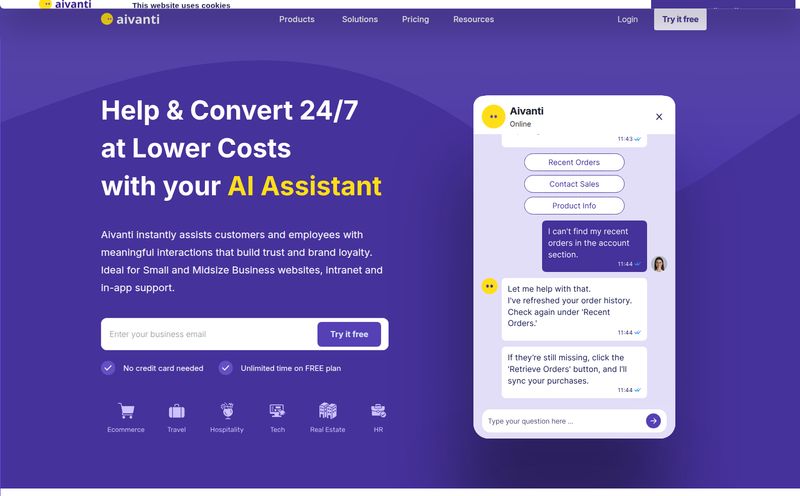Let’s talk elections. It doesn’t matter where you are in the world, the air around election time is always thick with a certain… tension. Hope, anxiety, and a healthy dose of suspicion. For years, we've relied on human poll watchers, exit polls, and a whole lot of trust in the system to ensure things are on the level. But in an age where a camera is on every corner, you have to wonder: couldn't technology do more?
Apparently, someone else was wondering that too. I recently stumbled across a tool called Revisor, which calls itself “Your Unblinking Poll Watcher.” And I’ve gotta say, the concept immediately grabbed me. It’s not just another piece of software; it's a neural network designed to watch video feeds from polling stations and do one thing: count. It counts voters, it spots irregularities, and it promises to hand the power of verification over to anyone, from journalists to independent observers.
It sounds like a silver bullet for election integrity. But as anyone who’s been in the tech and traffic game as long as I have knows, there's no such thing as a silver bullet. So, I did a little digging. Is this the real deal, or just another ambitious idea with too many holes? Let's take a look.
So, What Exactly is This Revisor Thing?
At its core, Revisor is an AI-powered software package. Think of it less as a person and more as a digital referee, its eyes glued to the game. It’s designed to be fed video footage from polling stations and, using its neural network brain, analyze what it sees. It’s not just looking for people; it’s looking for patterns, for actions, for things that don’t add up.
The company's own timeline shows this isn't some weekend project. They started with a prototype back in late 2019 and have been refining it ever since. The goal is simple and, frankly, admirable: make elections fully transparent and cut down on the potential for falsifications.

Visit The Revisor
The whole idea is to provide an objective dataset that can be checked against the official numbers. A second set of books, if you will, but written by a machine that couldn't care less about who wins. It just cares about the data.
The Nuts and Bolts: How Revisor Claims to Work
Now, here's where things get interesting. The Revisor website is a little... shy with the deep technical details. There’s a “How does it work?” page that, when I visited, was sadly empty. A classic 404. But based on the capabilities they list, we can piece together the process. It's a bit of digital detective work.
First, the AI has to learn the scene. It identifies the most important object in the room: the ballot box. That becomes its anchor point. From there, it tracks people as they approach the box. The system doesn't just add a tick mark for every person, it analyzes the action. One person, one ballot. Simple enough.
But its real power seems to lie in spotting anomalies. The website explicitly mentions detecting “ballot stuffing.” This implies the AI is trained to recognize suspicious behavior, like one person depositing multiple ballots, or a flurry of activity that doesn’t match the voter flow. It can even create a timeline of these potential violations, which is gold for anyone trying to build a case for a recount or investigation. It’s a pretty sophisticated approach that goes way beyond a simple headcount.
The Promise of Perfect Transparency: Revisor's Key Features
Revisor's feature set is where its ambition truly shines. It’s not just one trick pony. The Automated Voter Counting is the headline act, providing a raw, impartial turnout number. This alone could be a game-changer. Imagine being able to compare the AI's count of 5,000 voters with an official tally of 8,000. That’s a pretty big red flag.
Then there’s the Monitoring of Electoral Procedures. This is the fraud detection part. It’s the system’s ability to flag when someone's breaking the rules. The real-world examples they cite are pretty staggering. They mention processing over 4,000 hours of video from the 2020 Russian constitutional vote and, in a project with an investigative team, allegedly finding evidence of 17 million stuffed ballots. In another case study from Belarus, they reported finding evidence that 36% of votes in their sample were falsified.
Those are heavy-hitting claims. And it all leads to their biggest selling point: Independent Verification. This tool isn't just for governments. It’s for the watchdogs, the opposition parties, the journalists. It gives them the ammo to challenge official narratives with data-backed evidence. That's a powerful concept.
The Elephant in the Room: The Good, The Bad, and The Complicated
Alright, let's be real. No technology is perfect, especially one stepping into a minefield like election monitoring. There are some huge upsides here, but also some serious questions that need answers.
The Good Stuff
The biggest win is objectivity. An algorithm doesn't have a political affiliation. It just runs its code. This removes a layer of human bias that can, intentionally or not, creep into manual counting. It also offers incredible scale. Humans get tired, distracted, and bored. Revisor can analyze thousands of video streams simultaneously, 24/7, without a coffee break. The sheer volume of oversight it could provide is something human teams could never match. It also acts as a deterrent. If officials know a tireless AI is watching every move, they might think twice before trying anything shady.
The Complicated Bits
However, there are hurdles. Big ones. The first is what we in the biz call "garbage in, garbage out." The AI is completely at the mercy of the video quality. A poorly placed camera, bad lighting, or low-resolution footage could render the system useless. Its accuracy is tied directly to the quality of its input.
Then there’s the AI “black box” problem. Who trained this neural network? What data was it trained on? An AI trained primarily on footage from one country might have biases when analyzing footage from another. Without transparency into its training and algorithm, we're still being asked to just… trust. To truly be an open solution, we’d need an open-source audit of the code itself.
And then there's the biggest issue of all: privacy. Are we, as a society, comfortable with AI systems scanning and analyzing footage of every single citizen exercising their right to vote? What happens to this data? Who stores it? How is it protected? These are not small questions. They touch on some of our most fundamental civil liberties. Finally, the tool's biggest weakness is its dependence on access. It doesn't matter how great Revisor is if governments refuse to install cameras in polling stations or won't release the footage. An authoritarian regime isn't likely to hand over the very videos that could expose its fraud.
What's the Price for Fair Elections?
If you're wondering how much Revisor costs, you won't find a pricing page on their site. This is typical for a B2B or B2G (Business-to-Government) solution. My guess is that this is a high-ticket, enterprise-level service. You don't just download it and run it on your laptop. It's likely quoted on a case-by-case basis for large entities like electoral commissions, international observation missions, or major news organizations. The contact number listed has a Lithuanian country code (+370), suggesting a European base for the operation.
My Two Cents as an SEO and Tech Watcher
After looking at Revisor, I’m left cautiously optimistic. The potential is undeniable. In a world struggling with misinformation and declining trust in institutions, a tool that offers a shot of pure, unadulterated data is incredibly appealing.
But it's not a magic wand. Technology is always just a tool. Its impact is defined by the people who use it. Revisor could be a revolutionary force for democracy, or it could be a brilliant piece of tech that sits on a shelf because the political will to implement it doesn't exist. The challenges of access, potential bias, and serious privacy concerns are real and can't be brushed aside. It’s a classic case of the tech being the (relatively) easy part; navigating the human and political landscape is the real challenge.
Frequently Asked Questions about Revisor
- 1. Is Revisor a government entity?
- No, all signs point to Revisor being a private software package offered by a company, not an official government body.
- 2. Can Revisor be used in any election?
- Technically, yes, provided there is clear video footage of the polling station, specifically the ballot box area. Its use is entirely dependent on gaining access to that video feed.
- 3. How does Revisor handle voter privacy?
- This is a major unanswered question. The company has not provided clear public information on its data handling, storage, or privacy protection policies. This would be a critical point of inquiry for any organization considering its use.
- 4. Is the Revisor algorithm biased?
- It's a valid concern for any AI system. Without a public audit of its algorithm and training data, it’s impossible to independently verify its neutrality. The potential for hidden bias exists, as it does with any machine learning model.
- 5. What makes Revisor different from a human poll watcher?
- The main differences are scale and endurance. A human can only watch one location at a time and is prone to fatigue and distraction. Revisor can theoretically monitor thousands of locations simultaneously and never gets tired, providing a much broader and more consistent level of observation.
Final Thoughts
So, where does that leave us with Revisor? It's an exciting, powerful, and deeply necessary idea. It represents a new frontier in the fight for transparent and fair elections. But it's a tool that must be wielded with immense care. The path forward isn't just about deploying the software; it's about building a framework of policies around it that address privacy, ensure algorithmic transparency, and guarantee access. Revisor, or tools like it, might well be the future of election monitoring. But it's a future we need to step into with our eyes wide open, ready to ask the tough questions.
Reference and Sources
- The official Revisor website (as reviewed):
http://revisor.vision/ - For further reading on election technology and security, the Brennan Center for Justice provides excellent resources.



